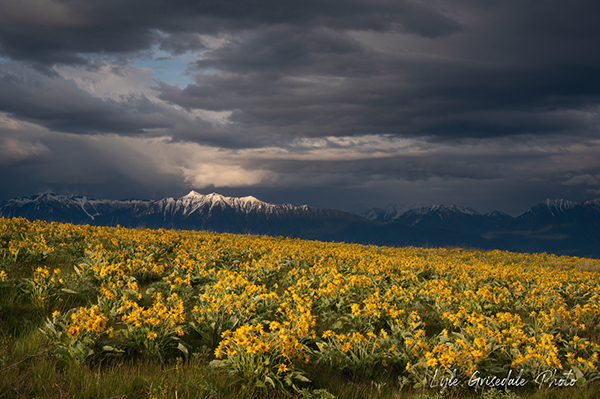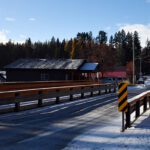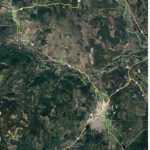Home »

Spring’s yellow carpet
Early May brings the East Kootenay’s most stunning and best-known floral display, arrowleaf balsamroot. Colloquially known as Okanagan sunflower in the Okanagan or Oregon sunflower in Oregon, it’s just plain sunflower here in the Kootenays. I guess we’re more modest and don’t claim it as our own.
Far from a regional specialty, balsamroot has a wide range across western North America. It occurs from Arizona north to B.C.’s Cariboo region and California east to Colorado and the Black Hills of South Dakota. As you move from south to north, balsamroot grows at lower elevations. In California and Arizona it’s known as a mountain plant. By the time you get to British Columbia, it occurs mostly in valley bottoms like the Rocky Mountain Trench here in the East Kootenay.
Certainly it does not like heat. A few days of unseasonable warmth here is enough to wilt the flowers and bring an early end to the stunning vistas they provide.

The sunflower moniker is apt as the plant does belong to the sunflower family. To Ktunaxa, it is xaⱡ (“hath” is an approximate pronunciation) and a very important plant with myriad uses. Roots, shoots, blossoms, seeds – all have value.
The plant grows 30 to 60 cm tall and produce a brilliant yellow flower that is more complicated than it looks. Known to botanists as ‘inflorescences,’ they are composed of several tiny florets. Each apparent petal on the bloom arises from a single floret comprised of one enormous petal and several tiny ones. There’s a lot going on in those big yellow blooms!
Balsamroot is perhaps the most photographed wildflower in B.C.’s interior. Many people have a favourite spot to take in spring’s yellow carpet. Eager Hill, Wycliffe Buttes, Kimberley Nature Park’s Sunflower Hill or almost any open forest site in the Rocky Mountain Trench that you can think of. The plant is associated with bunchgrass and fescue prairies as well as open ponderosa pine forests.
Like many grassland and open forest plants, balsamroot is well adapted to the low-intensity, frequent fire regimes that defined most of western North America before Smoky the Bear and company ill-advisedly decided all fire needed to be immediately snuffed out. This picture shows xaⱡ in bloom a mere two weeks after a low-intensity prescribed fire was applied to the landscape. As you can see, many other plants are rapidly sprouting from the charred surface but otherwise undamaged soil. As long as the caudex (top of the taproot) is not damaged, balsamroot quickly regenerates.
 The reason for this ability to regenerate so quickly is because the vast majority of balsamroot is under ground. A common adaptation of grassland plants is a large, thick taproot that reaches great depths to ensure moisture is not limiting and the food energy produced during the short spring growing season can be safely stored until needed to produce leaves and blooms next year. The root contains a resin that gives “balsamroot” its name.
The reason for this ability to regenerate so quickly is because the vast majority of balsamroot is under ground. A common adaptation of grassland plants is a large, thick taproot that reaches great depths to ensure moisture is not limiting and the food energy produced during the short spring growing season can be safely stored until needed to produce leaves and blooms next year. The root contains a resin that gives “balsamroot” its name.
The taproot can be up to 10 cm across and has been recorded as deep as 2.7 metres (almost nine feet). The root extends downward for about 15 cm, then sends laterals out more-or-less horizontally to distances up to one metre. These laterals then turn down and reach depths of 1.5 m or more. The plant is well-rooted!
 Well rooted perhaps, but not in a hurry. Seeds may take two or three years to germinate and another three to five years to start fully producing flowers. The large, dramatic plants we enjoy are likely a decade or more old and the plant will survive for much longer. When you consider the biomass of the plant that is below ground and that must be built from leaves that are viable for less than two months a year, it’s not surprising that xaⱡ is such a slow-growing species.
Well rooted perhaps, but not in a hurry. Seeds may take two or three years to germinate and another three to five years to start fully producing flowers. The large, dramatic plants we enjoy are likely a decade or more old and the plant will survive for much longer. When you consider the biomass of the plant that is below ground and that must be built from leaves that are viable for less than two months a year, it’s not surprising that xaⱡ is such a slow-growing species.
Consider too that fire historically passed through most of the Trench every 10 to 15 years, on average. Each balsamroot plant could have survived more than one burn in its lifetime. More than just a pretty flower, arrowleaf balsamroot is a worthy ambassador of our grasslands and open forests.
Ian Adams is a wildlife ecologist living near Cranbrook. He finds it impossible to pass balsamroot without taking a picture. He continues his quest for the perfect xaⱡ image.
Lead and above images: Recent images of arrowleaf balsamroot growing in Wycliffe. Lyle Grisedale photos
e-KNOW








